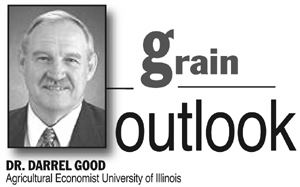|
Potential Changes In Corn And Soybean Acreage Estimates

As the Midwest corn and soybean harvest accelerates, most of the production attention is focused on yield reports. Still, last week’s report of planted acreage from the USDA’s Farm Service Agency (FSA) leaves some uncertainty about the magnitude of planted and harvested acreage of those crops.
For corn, acreage that had been reported to FSA as planted totaled 91.428 million, 2.657 million more than reported the previous month. Based on survey data, the USDA’s National Agricultural Statistics Service (NASS) has estimated planted acreage at 97.379 million acres. Acreage reported to FSA is expected to be less than the NASS estimate since not all producers are enrolled in programs that require reporting of planted acreage to the FSA. Planted acreage reported to FSA as of the September report accounted for 93.9 percent of the total estimated by NASS and the difference was 5.951 million acres. Over the previous six years, the final total corn acreage reported to FSA averaged 96.9 percent of the final NASS estimate, in a range of 96.4 to 97.5 percent. The difference between the FSA and NASS acreage estimates averaged 2.785 million acres, in a range of 2.381 in 2007 to 3.295 million in 2011.
Recent history suggests that the difference between the corn acreage reported to FSA and acreage estimated by NASS this year will be smaller when final estimates are available. If the final difference is equal to the largest difference of the past six years (2011), the gap will narrow by 2.5 to 2.6 million acres. Planted acreage of corn reported to FSA increased from September to the final estimate by only 228,000 acres in 2011 and 213,000 in 2012. The increase may be larger this year due to the lateness of planting and the extension of the FSA deadline for reporting planted acreage. It would be a surprise if the increase totaled 2.5 to 2.6 million acres, leading to the expectation that the NASS estimate of planted acreage may be reduced in future Crop Production reports.
The question is whether any reduction in the NASS estimate of corn planted acreage, and acreage harvested for grain, could be large enough to alter prospects of a substantial increase in corn stocks by the end of the current marketing year. Historically, the final estimate of planted acreage has not differed from the June estimate by large amounts. The largest differences in the previous 10 years were in 2006 and 2008, when the final estimates were 1.039 million (1.3 percent) and 1.345 million (1.5 percent) less than the June estimates, respectively. A similar decline this year would point to a 1.3 to 1.4 million acre reduction in the estimate of planted acreage. Such a decline would require the FSA report of planted acreage to increase by about 1.2 million acres in order to narrow the gap between the two estimates into the historical range. Such an increase would be outside the recent experience, suggesting the NASS estimate could be reduced by as much as two million acres. With an average yield near 155 bushels, a two million acre reduction in the estimate of harvested acreage would reduce the production estimate by 310 million bushels and result in year ending stocks of about 1.545 billion bushels, based on current consumption forecasts.
For soybeans, acreage that had been reported to FSA as planted totaled 74.659 million, 2.598 million more than reported the previous month. Based on survey data, NASS has estimated planted acreage at 77.178 million acres. Planted acreage reported to FSA as of the September report accounted for 96.7 percent of the total estimated by NASS and the difference was 2.519 million acres. Over the previous six years, the final total soybean acreage reported to FSA averaged 98.2 percent of the final NASS estimate of planted acreage, in a range of 97.1 to 98.8 percent. The difference between the FSA and NASS acreage estimates averaged 1.304 million acres, in a range of 0.917 million in 2008 to 1.884 million in 2007. History suggests that the current gap between FSA and NASS acreage numbers will narrow by about one million acres. Planted acreage of soybeans reported to FSA increased from September to the final estimate by only 190,000 acres in 2011 and 161,000 in 2012, suggesting that the NASS estimate this year could be reduced by as much as 800,000 acres. That is not a large decline and is well within the experience of the past 10 years. With an average yield of 41.2 bushels, an 800,000 acre reduction in the estimate of harvested acreage would reduce the soybean production estimate by 33 million bushels and result in year ending stocks of about 120 million bushels, based on current consumption forecasts.
Depending on average yield, the potential change in the estimate of harvested acreage of corn is not likely to be large enough to alter prospects of surplus supplies, but could be large enough to stabilize corn prices. Any change in the estimate of harvested acreage of soybeans is not expected to be large, but could confirm prospects for another year of very tight stocks that would support prices at or above the current level.∆
DR. DARREL GOOD: Agricultural Economist, University of Illinois
|
|